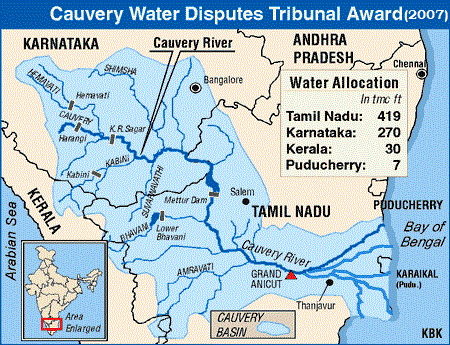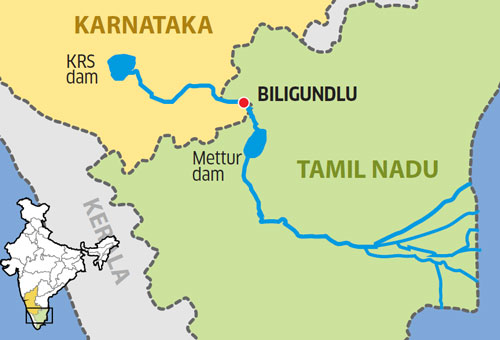Why in news?
The Supreme Court has pronounced its verdict on the sharing of Cauvery water among Tamil Nadu, Puducherry, Karnataka and Kerala.
How did the Cauvery dispute emerge?
- Historically, Tamil Nadu used about 602 TMC of the total yield of the river i.e. the available water in a particular year.
- As a result, only about 138 TMC was available for Karnataka until the turn of the 20th century.
- In 1924, Tamil Nadu built the Mettur dam across the Cauvery river.
- Subsequently, Karnataka and Tamil Nadu signed an agreement effective for 50 years.
- Accordingly, Tamil Nadu was allowed to expand its agricultural area by 11 lakh acres from the existing 16 lakh acres.
- Karnataka was authorised to increase its irrigation area from 3 lakh acres to 10 lakh acres.

- The Cauvery River thus primarily served the needs of farmers in Tamil Nadu.
- On completing 50 years, the accord lapsed in 1974.
- Subsequently, Karnataka claimed that the agreement restricted its ability to develop farming activities along the Cauvery basin.
- To make up the lost ground, Karnataka attempted to expand farming activities in the Cauvery basin.
- It started building reservoirs.
- With this, the Cauvery river water sharing issue emerged.
- It is now a major water sharing dispute among Tamil Nadu, Karnataka, Puducherry and Kerala.
- Tribunal - By Tamil Nadu's demand, the Union government formed the Cauvery Water Disputes Tribunal (CWDT) in 1990.
- The dispute was adjudicated by the CWDT in 2007.
What was the Tribunal's order?
- According to the tribunal's order, the total availability of water in the 802-km long Cauvery basin is 740 tmc in a normal year.
- Of the total 740 thousand million cubic feet (TMC) of water available for utilisation -
- 419 TMC was awarded to Tamil Nadu
- 270 TMC to Karnataka
- 30 TMC to Kerala
- 7 TMC to Puducherry
- The remaining 14 TMC was reserved for environmental protection.
- To acheive this sharing, the order stated that Karnataka must release 192 TMC of water from Biligundlu Station (inter-state dam) in normal monsoon years.

- This should be at the rates specified by the tribunal for each month.
- The tribunal also noted that in case the yield was less in a distress year, the allocated shares shall be proportionately reduced.
What was the response?
- Both Tamil Nadu and Karnataka challenged the tribunal’s order.
- Karnataka claimed 312 TMC of water as against the 270 TMC ordered by the tribunal.
- The court reserved its order in September 2017.
What is the present SC verdict?
- The Court declared Cauvery a “national asset”.
- It upheld the principle of equitable apportionment of inter-State river water among riparian States.
- The judgment concluded that the CWDT did not take into account Tamil Nadu's stock of an “empirical” 20 TMC of ground water.
- Accordingly, Karnataka is "entitled to marginal relief".
- In its present verdict, the Supreme Court has thus reduced the allocation of Cauvery water from Karnataka to Tamil Nadu.

- This means a reduction of 14.75 TMC quota of Cauvery water to Tamil Nadu from the earlier 192 TMC as stipulated by the tribunal.
- This change will be adjusted from the Biligundlu site.
- Karnataka will now release only 177.25 TMC Cauvery water from Billigundlu site to Mettur dam in Tamil Nadu.
- The SC has given the Centre 6 weeks to frame a scheme to make sure the final decisions are implemented.
- SC has also directed the formation of the Cauvery Management Board (CMB) immediately.
-
CMB will be an inter-state forum which will work to ensure the implementation of orders of the CWDT.
-
The Board shall be under the control of the Ministry of Water Resources.
-
The members of the Board will include a Chairman, two full-time members, and representatives of the central government and each of the four states.
-
The expenses of the Board will be borne by the state governments.
Source: The Indian Express, The Hindu


